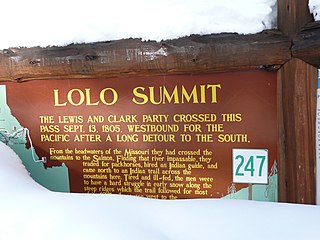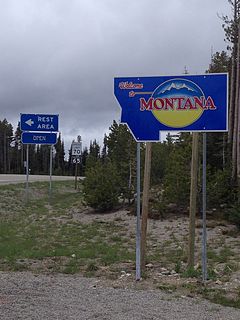Related Research Articles

Lemhi County is a county located in the U.S. state of Idaho. As of the 2020 census, the population was 7,974. The largest city and county seat is Salmon. The county was established in 1869, named after Fort Lemhi, a remote Mormon missionary settlement from 1855 to 1858 in Bannock and Shoshone territory.

The Bitterroot Range is a mountain range and a subrange of the Rocky Mountains that runs along the border of Montana and Idaho in the northwestern United States. The range spans an area of 24,223 square miles (62,740 km2) and is named after the bitterroot, a small pink flower that is the state flower of Montana.
The Shoshone or Shoshoni are a Native American tribe with four large cultural/linguistic divisions:

The Salmon River, also known as "The River of No Return", is a river located in the U.S. state of Idaho in the western United States. It flows for 425 miles (685 km) through central Idaho, draining a rugged, thinly populated watershed of 14,000 square miles (36,000 km2). The river drops more than 7,000 feet (2,100 m) from its headwaters, near Galena Summit above the Sawtooth Valley in the Sawtooth National Recreation Area, to its confluence with the Snake River. Measured at White Bird, its average discharge is 11,060 cubic feet per second. The Salmon River is the longest undammed river in the contiguous United States and the longest within a single state outside Alaska.

Lolo Pass, elevation 5,233 feet (1,595 m), is a mountain pass in the western United States, in the Bitterroot Range of the northern Rocky Mountains. It is on the border between the states of Montana and Idaho, approximately forty miles (65 km) west-southwest of Missoula, Montana.

Lemhi Pass is a high mountain pass in the Beaverhead Mountains, part of the Bitterroot Range in the Rocky Mountains and within Salmon-Challis National Forest. The pass lies on the Montana-Idaho border on the continental divide, at an elevation of 7,373 feet (2,247 m) above sea level. It is accessed via Lemhi Pass Road in Montana, and the Lewis and Clark Highway in Idaho, both dirt roads. Warm Springs Road, which roughly follows the divide in Montana, passes just west of the pass's high point.

Salmon–Challis National Forest is located in east central sections of the U.S. state of Idaho. At 4,235,940 acres it is one of the largest national forests in the lower 48 states and also has most of the land area of the Frank Church–River of No Return Wilderness, which is the largest wilderness area south of Alaska.
Cameahwait was the brother of Sacagawea, and a Shoshone chief. He was the head of the first group of inhabitants of modern-day Idaho who were encountered by Europeans.

Big Hole Pass is a high mountain pass in the northern Rocky Mountains of the western United States. It is on the Montana–Idaho border, approximately eight miles (13 km) due south of Montana State Highway 43 in the Beaverhead–Deerlodge National Forest in Beaverhead County, Montana, and Salmon National Forest in Lemhi County, Idaho. This location should not be confused with a sign on Montana Highway 278 at the height of land west of Dillon, that denotes the eastern entrance to the Big Hole valley.

Lost Trail Pass is a mountain pass in the Rocky Mountains of the northwestern United States, on the border of Idaho and Montana in the Bitterroot Mountains. The pass is at an elevation of 7,014 feet (2,138 m) above sea level and is traversed by U.S. Highway 93.

The Lemhi River is a 60-mile-long (97 km) river in Idaho in the United States. It is a tributary of the Salmon River, which in turn is tributary to the Snake River and Columbia River.

U.S. Route 93 (US-93) is a north–south U.S. Highway in the U.S. state of Idaho.

Tendoy is an unincorporated rural service point in Lemhi County, Idaho, United States, located at 44°57′34″N113°38′41″W on State Highway 28, at an altitude of 4,842 feet (1,476 m). It consists of a small general store and house. It was named for Tendoy, a prominent Lemhi Shoshone chief in the mid-19th century.

Sacagawea was a Lemhi Shoshone woman who, in her teens, helped the Lewis and Clark Expedition in achieving their chartered mission objectives by exploring the Louisiana Territory. Sacagawea traveled with the expedition thousands of miles from North Dakota to the Pacific Ocean, helping to establish cultural contacts with Native American people and contributing to the expedition's knowledge of natural history in different regions.

North Fork is an unincorporated community in Lemhi County, Idaho.

Eastern Shoshone are Shoshone who primarily live in Wyoming and in the northeast corner of the Great Basin where Utah, Idaho and Wyoming meet and are in the Great Basin classification of Indigenous People. They lived in the Rocky Mountains during the 1805 Lewis and Clark Expedition and adopted Plains horse culture in contrast to Western Shoshone that maintained a Great Basin culture.

The Lemhi Shoshone are a tribe of Northern Shoshone, also called the Akaitikka, Agaidika, or "Eaters of Salmon". The name "Lemhi" comes from Fort Lemhi, a Mormon mission to this group. They traditionally lived in the Lemhi River Valley and along the upper Salmon River in Idaho. Bands were very fluid and nomadic, and they often interacted with and intermarried other bands of Shoshone and other tribes, such as the Bannock. Today most of them are enrolled in the Shoshone-Bannock Tribes of the Fort Hall Reservation of Idaho.
Fort Lemhi was a mission approximately two miles (3 km) north of present-day Tendoy, Idaho, occupied by Mormon missionaries from 1855 to 1858.

The Lemhi Reservation was a United States Indian Reservation for the Lemhi Shoshone from 1875 to 1907. During almost all this time their main chief was Tendoy.

Northern Shoshone are Shoshone of the Snake River Plain of southern Idaho and the northeast of the Great Basin where Idaho, Wyoming and Utah meet. They are culturally affiliated with the Bannock people and are in the Great Basin classification of Indigenous People.
References
- 1 2 3 4 ""Swooping Eagle." Lemhi-Shoshone. Retrieved 14 June 2010.
- 1 2 Ontko, Gale. Thunder Over the Ochoco, Volume I: The Gathering Storm, Bend, OR: Maverick Publications, Inc., 1997.
- 1 2 http://lewisandclarkjournals.unl.edu/read/?_xmlsrc=1805-08-20.xml&_xslsrc=LCstyles.xsl. Archived 2011-06-16 at the Wayback Machine